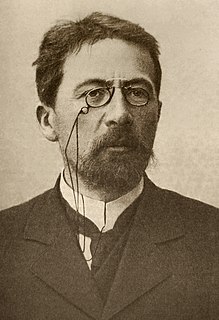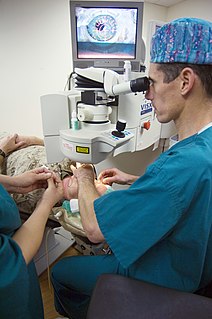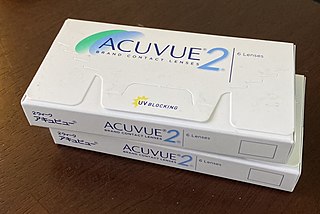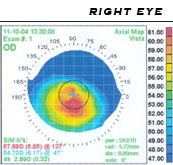
Bausch + Lomb is an eye health products company based in Laval, Quebec, Canada. It is one of the world's largest suppliers of contact lenses, lens care products, pharmaceuticals, intraocular lenses, and other eye surgery products. The company was founded in Rochester, New York, United States in 1853 by optician John Bausch and cabinet maker turned financial backer Henry Lomb. Until its sale in 2013, Bausch + Lomb was one of the oldest continually operating companies in the US.

Pince-nez is a style of glasses, popular in the late 19th and early 20th centuries, that are supported without earpieces, by pinching the bridge of the nose. The name comes from French pincer, "to pinch", and nez, "nose".
Ignipuncture is the procedure of closing a retinal separation by transfixation of the break via cauterization. The procedure was pioneered and named by Jules Gonin in the early 1900s. Due to the risk of severe complications and the advent of lasers for the controlled delivery of energy, ignipuncture became an obsolete procedure; since the 1980s, ignipuncture has been performed using safer techniques like endophotocoagulation.

LASIK or Lasik, commonly referred to as laser eye surgery or laser vision correction, is a type of refractive surgery for the correction of myopia, hyperopia, and astigmatism. LASIK surgery is performed by an ophthalmologist who uses a laser or microkeratome to reshape the eye's cornea in order to improve visual acuity. For most people, LASIK provides a long-lasting alternative to eyeglasses or contact lenses.

Presbyopia is physiological insufficiency of accommodation associated with the aging of the eye that results in progressively worsening ability to focus clearly on close objects. Symptoms include difficulty reading small print, having to hold reading material farther away, headaches, and eyestrain. Different people will have different degrees of problems. Other types of refractive errors may exist at the same time as presbyopia.

An eyeglass prescription is an order written by an eyewear prescriber, such as an optometrist, that specifies the value of all parameters the prescriber has deemed necessary to construct and/or dispense corrective lenses appropriate for a patient. If an examination indicates that corrective lenses are appropriate, the prescriber generally provides the patient with an eyewear prescription at the conclusion of the exam.
An optical system with astigmatism is one where rays that propagate in two perpendicular planes have different foci. If an optical system with astigmatism is used to form an image of a cross, the vertical and horizontal lines will be in sharp focus at two different distances. The term comes from the Greek α- (a-) meaning "without" and στίγμα (stigma), "a mark, spot, puncture".

Radial keratotomy (RK) is a refractive surgical procedure to correct myopia (nearsightedness) that was developed in 1974, by Svyatoslav Fyodorov, a Russian ophthalmologist. It has been largely supplanted by newer operations, such as photorefractive keratectomy, LASIK, Epi-LASIK and the phakic intraocular lens.

Refractive eye surgery is non-essential eye surgery used to improve the refractive state of the eye and decrease or eliminate dependency on glasses or contact lenses. This can include various methods of surgical remodeling of the cornea (keratomileusis), lens implantation or lens replacement. The most common methods today use excimer lasers to reshape the curvature of the cornea. Successful refractive eye surgery can reduce or cure common vision disorders such as myopia, hyperopia, presbyopia and astigmatism.

Intraocular lens (IOL) is a lens implanted in the eye as part of a treatment for cataracts or myopia. The most common type of IOL is the pseudophakic IOL. These are implanted during cataract surgery, after the cloudy eye's natural lens has been removed. The pseudophakic IOL provides the same light focusing function as the natural crystalline lens. The second type of IOL, more commonly known as a phakic intraocular lens (PIOL), is a lens which is placed over the existing natural lens and is used in refractive surgery to change the eye's optical power as a treatment for myopia (nearsightedness).
Trifocals are eyeglasses with lenses that have three regions which correct for distance, intermediate, and near vision. John Isaac Hawkins developed the trifocal lens in 1827.

Refractive error, also known as refraction error, is a problem with focusing light accurately on the retina due to the shape of the eye. The most common types of refractive error are near-sightedness, far-sightedness, astigmatism, and presbyopia. Near-sightedness results in far away objects being blurry, far-sightedness and presbyopia result in close objects being blurry, and astigmatism causes objects to appear stretched out or blurry. Other symptoms may include double vision, headaches, and eye strain.

Acuvue is a brand of disposable contact lenses made in Jacksonville Florida and Limerick-based Vistakon, a subsidiary of Johnson & Johnson (J&J).

Corneal topography, also known as photokeratoscopy or videokeratography, is a non-invasive medical imaging technique for mapping the surface curvature of the cornea, the outer structure of the eye. Since the cornea is normally responsible for some 70% of the eye's refractive power, its topography is of critical importance in determining the quality of vision and corneal health.

Astigmatism is a type of refractive error in which the eye does not focus light evenly on the retina. This results in distorted or blurred vision at any distance. Other symptoms can include eyestrain, headaches, and trouble driving at night. If it occurs in early life, it can later result in amblyopia.
The eye–hand span is the distance across part of a text, usually a linguistic text that is being copied via typing or a piece of notated music that is being performed, defined as the distance between the position of the eyes acquiring that information and the hand(s) typing or performing it. Specifically, the eye–hand span is typically measured from the location of central visual input, and stretches between the syllable or chord currently being typed or performed, and the lateral location of the simultaneous fixation. This distance may be measured either in units of linear measurement or in characters or other "bits" of data. Some authors refer to the eye–hand span as the "perceptual span" for the visual information perceivable around the region of center of vision used in reading, and in some cases including peripheral input. The eye–hand span is analogous to the eye–voice span in reading language aloud and in singing.

A cylindrical lens is a lens which focuses light into a line instead of a point, as a spherical lens would. The curved face or faces of a cylindrical lens are sections of a cylinder, and focus the image passing through it into a line parallel to the intersection of the surface of the lens and a plane tangent to it. The lens compresses the image in the direction perpendicular to this line, and leaves it unaltered in the direction parallel to it.
The Alpins Method, developed by Australian ophthalmologist Noel Alpins, is a system to plan and analyze the results of refractive surgical procedures, such as laser in-situ keratomileus (LASIK). The Alpins Method is also used to plan cataract/toric intraocular lens (IOL) surgical procedures.

A three-mirror anastigmat is an anastigmat telescope built with three curved mirrors, enabling it to minimize all three main optical aberrations – spherical aberration, coma, and astigmatism. This is primarily used to enable wide fields of view, much larger than possible with telescopes with just one or two curved surfaces.
Terrien marginal degeneration is a noninflammatory, unilateral or asymmetrically bilateral, slowly progressive thinning of the peripheral corneal stroma.













